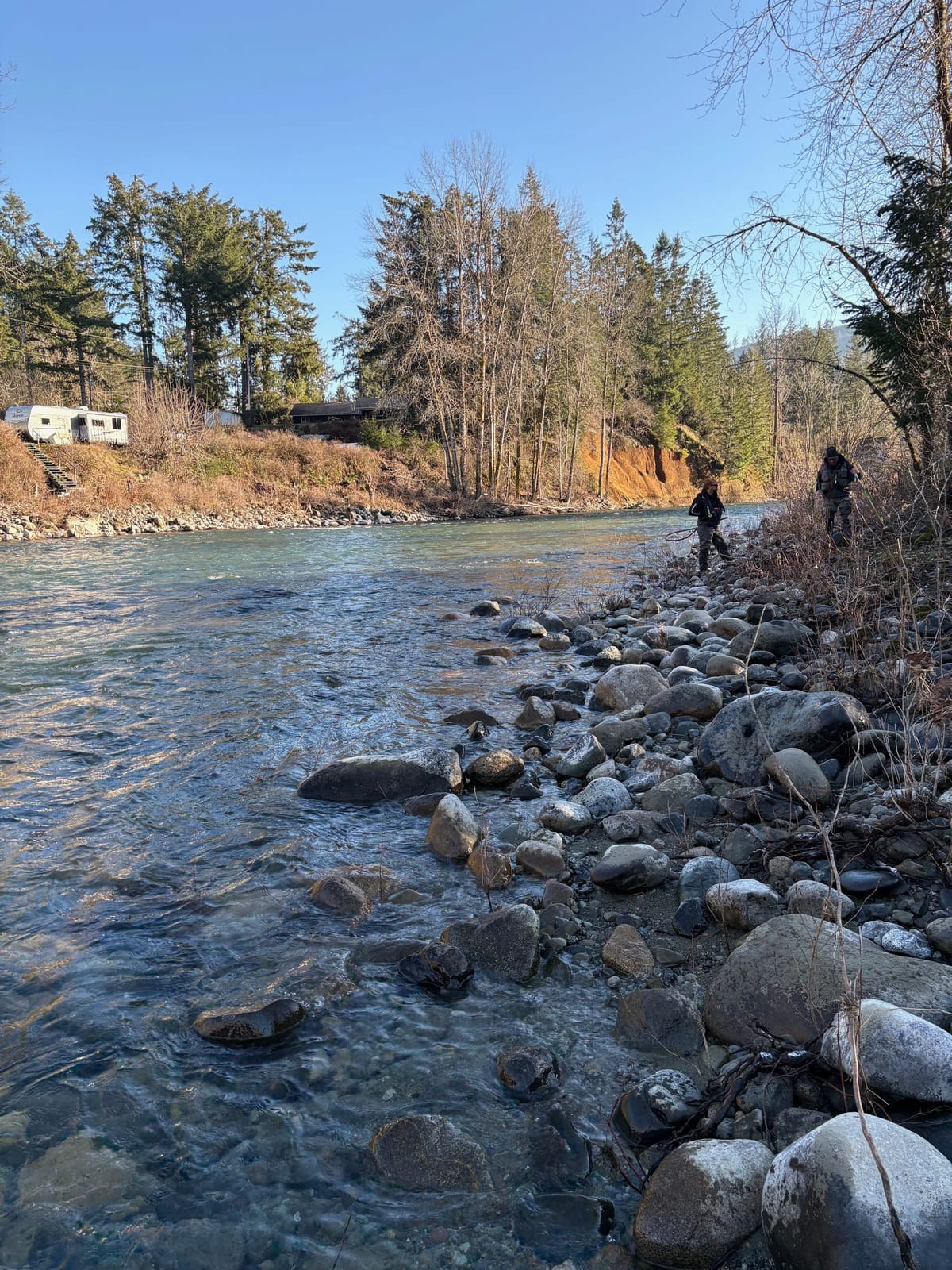Hire a winter steelhead guide, catch more steelhead

To be a better winter steelhead fly angler, you’ve got to humble yourself once and a while.
You’ve got to put yourself on a raft with the sharpest guide you can find and open yourself up to their wisdom.
Thanks for reading the dull hook! Subscribe for free to receive new posts and support my work.
Subscribed
Thanks for reading! Subscribe for free to receive new posts and support my work.
Hiring a guide isn’t just about increasing your chances of finding fish; you get perspective on what you’re doing right and wrong with your swing. This can make all the difference.
Of course, to learn, you must be open to feedback and being wrong.
You must have a small ego or be working towards developing a smaller one.
The other day, I fished the Cowichan River with a guide, and it made all the difference.
I always kick off a day with a guide by letting them know I’m open to feedback and instruction, and last Wednesday was no different:
Tell me what I’m fucking up, I say to the guide that’s roughly my age. That’s what I’m paying you for. You may think I’m here to catch fish, and I am, but I’m also here to increase the size of my compendium. Throw in the odd compliment though, I don’t want to feel like a total bag of shit at the end of the day.
They usually nod and say, “You sure?”
Yeah, let me have it, man.
Then we get on with the day.
After a few weak double spey casts, I get my first dose of advice.
The guide, Andrew, helps me with my cast, which used to be my best cast; today, however, it looks like garbage because I’m on river-right, my weak side. I never fish river-right anymore.
After I work the kinks out of my cast, we hop back on the raft and move to the next run. We dead drift bugs in between runs on a Euro nymph setup.
It helps to have a small ego when working with a guide; less ego helps the guide’s advice work its way into your brain, down into your arms and hands, and ultimately into the spey rod, line, and fly. Good advice catches steelhead, not shiny intruder flies.
Winter steelhead have a way of humbling fly anglers; good advice is the countermeasure.
Good advice helps build confidence when winter fishing, and it’s easy to lose it.
Indeed, after you get skunked several times out, it’s easy to start questioning yourself about tactics:
- Am I using the wrong sink tip?
- Should I take the FIST off and use a lighter head?
- Is my fly swimming slow enough?
- Too much belly in my line?
- What about my depth? – too deep?
- Does fly pattern matter?
There are many variables to consider and an analytical fly angler can drive themselves crazy.
“Sometimes I leave the same sink tip on all day, no matter the run.”
Thank you! This makes me feel so much better, I reply.
“I just get lazy,” he says.
I’m glad I’m not the only one.
Standing in one of the last runs of the day, I cast, throw a big upstream mend, take a few big steps, and let the fly dead drift and sink.
Then it starts swinging a slow swing. The fly is swimming.
“You know, that looks pretty good. I know we haven’t had any grabs today, but that’s what I’d be doing if I were you. If you keep doing that, it’s only a matter of time. You’ve got to grind it out.”
That was probably the best piece of advice I heard all day. It wasn’t even advice, just a pat on the back.
So, I’m not doomed?
“It takes 120+ hours of casting to get a grab on this river, in my experience.”
“And right now, the steelhead are deep because the water’s so clear - they’re hiding from eagles. You’ve got to get that fly down. Get into the mind of rainbow trout because that’s all these guys are – ask yourself, where would a ‘bow hide?”
I don’t think much about fish psychology; I’m usually too busy thinking about gear.
We worked the runs hard last week, but we caught no steelhead. We moved some fish though, that’s for sure.
I told the guide my expectations were low — they still are.
But as I said to him at the end of the day, you got me thinking more about how to be a better winter steelhead angler.
And that’s what a good guide does – they get you thinking.
That perspective can make all the difference when you’ve been flogging the water for hours without success.
They help get you out of your head and that repetitive loop of second-guessing every little detail.
Sometimes, it’s not about the fish but about refining and improving the swing process and knowing that every cast, mend, and swing is a brushstroke in a much larger painting.
